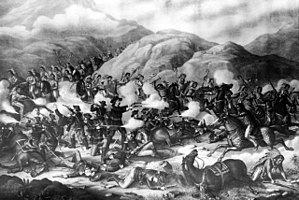Great Sioux War of 1876-77
| Great Sioux War of 1876 | |||||||
|---|---|---|---|---|---|---|---|
| Part of the Sioux Wars, American Indian Wars | |||||||
 Custer's last stand at Little Bighorn in the Crow Indian Reservation. |
|||||||
|
|||||||
| Belligerents | |||||||
| Commanders and leaders | |||||||
| Casualties and losses | |||||||
| 310 killed | 265 killed | ||||||
The Great Sioux War of 1876, also known as the Black Hills War, was a series of battles and negotiations which occurred between 1876 and 1877 between the Lakota Sioux, and Northern Cheyenne and the government of the United States. The cause of the war was the desire of the U.S. government to obtain ownership of the Black Hills. Gold had been discovered in the Black Hills, settlers began to encroach onto Native American lands, and the Sioux and Cheyenne refused to cede ownership to the U.S. Traditionally, the United States military and historians place the Lakota at the center of the story, especially given their numbers, but some Indians believe the Cheyenne were the primary target of the U.S. campaign.
Among the many battles and skirmishes of the war was the Battle of the Little Bighorn, often known as Custer's Last Stand, the most storied of the many encounters between the U.S. army and mounted Plains Indians. That Indian victory notwithstanding, the U.S. leveraged national resources to force the Indians to surrender, primarily by attacking and destroying their encampments and property. The Great Sioux War took place under the presidencies of Ulysses S. Grant and Rutherford B. Hayes. The Agreement of 1877 (19 Stat. 254, enacted February 28, 1877) officially annexed Sioux land and permanently established Indian reservations.
The Cheyenne had migrated west to the Black Hills and Powder River Country before the Lakota and introduced them to horse culture about 1730. By the late 18th century, the growing Lakota tribe had begun expanding its territory west of the Missouri River. They pushed out the Kiowa and formed alliances with the Cheyenne and Arapaho to gain control of the rich buffalo hunting grounds of the northern Great Plains. The Black Hills, located in present-day western South Dakota, became an important source to the Lakota for lodge poles, plant resources and small game. They are considered sacred to the Lakota culture.
...
Wikipedia
